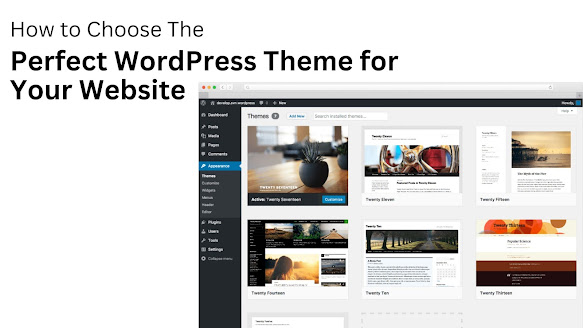How to Choose the Perfect WordPress Theme for Your Website
Choosing the perfect WordPress theme for your website is crucial for establishing a strong online presence. The right theme not only affects your site's aesthetic appeal but also impacts its functionality, performance, and overall user experience. With thousands of themes available, selecting the ideal one can be overwhelming. This comprehensive guide will walk you through the essential factors to consider when choosing a WordPress theme, ensuring you make an informed decision that aligns with your website’s goals and needs.
Understanding Your Website’s Needs
Before diving into theme selection, it’s vital to understand your website’s requirements. Different types of websites have different needs, so clarifying your objectives will help you choose a theme that best fits those goals.
1. Define Your Website’s Purpose
Determine the primary purpose of your website. Are you creating a blog, an online store, a portfolio, or a business site? Each type of website has unique requirements:
- Blog: Focus on readability, typography, and a clean layout.
- E-Commerce: Prioritize product display, shopping cart functionality, and payment integration.
- Portfolio: Look for themes with strong visual elements and showcase capabilities.
- Business: Choose a theme with a professional design, easy navigation, and contact options.
Introducing SFWPExperts excels in creating custom WordPress website designs tailored to your needs. Our expertise in theme selection and optimization ensures your site’s design aligns perfectly with your brand’s goals and delivers exceptional user experience. Trust us to guide you in choosing the ideal theme and implementing it for peak performance.
2. Consider Your Target Audience
Understanding your target audience is crucial in selecting a theme that resonates with them. Consider their preferences, behavior, and device usage. A responsive theme that looks great on all devices is essential, especially given the growing mobile user base.
3. List Your Essential Features
Make a list of features that are essential for your website. This could include:
- Customizable headers and footers
- Drag-and-drop page builders
- SEO-friendly design
- Social media integration
- Custom widgets and sidebars
- Multilingual support
Having a clear list of features will help you narrow down your options and find a theme that meets your specific needs.
Key Factors to Consider When Choosing a WordPress Theme
1. Design and Aesthetics
The design of your theme plays a significant role in the overall appearance of your website. Look for a theme that aligns with your brand’s identity and appeals to your target audience. Consider the following:
- Visual Appeal: Choose a theme with a modern, attractive design that reflects your brand’s style.
- Color Schemes and Fonts: Ensure the theme supports custom color schemes and fonts to match your brand guidelines.
- Layout Options: Look for themes with flexible layout options that allow you to create a unique design.
2. Responsiveness and Mobile Friendliness
With a significant amount of web traffic coming from mobile devices, it’s crucial to choose a responsive theme. A responsive theme automatically adjusts to different screen sizes and devices, ensuring a seamless user experience on smartphones, tablets, and desktops.
3. Customization Options
Customization options are essential for tailoring your theme to your specific needs. Check for themes that offer:
- Theme Customizer: A built-in customizer allows you to make changes and see them in real-time.
- Page Builders: Drag-and-drop page builders like Elementor or WPBakery offer easy customization without coding.
- Theme Options Panel: This provides additional customization features and settings for adjusting the look and functionality of your site.
4. Performance and Speed
A theme’s performance directly impacts your website’s loading speed. Choose a theme optimized for speed and performance:
- Lightweight Design: Avoid themes with excessive features or heavy scripts that can slow down your site.
- Optimized Code: Ensure the theme’s code is clean and optimized for fast loading times.
- Performance Testing: Test the theme’s performance using tools like Google PageSpeed Insights or GTmetrix.
5. Compatibility with Plugins
Ensure that the theme you choose is compatible with essential plugins. WordPress plugins add functionality to your site, such as SEO, security, and social media integration. Check the theme’s documentation or support forums to confirm compatibility with popular plugins.
6. SEO Friendliness
An SEO-friendly theme helps improve your site’s search engine rankings. Look for themes that offer:
- Clean Code: Properly coded themes with valid HTML and CSS are better for SEO.
- Schema Markup: Schema markup enhances search engine understanding of your content.
- Built-in SEO Features: Some themes include built-in SEO options or compatibility with SEO plugins.
Read More: How to Choose the Perfect WordPress Theme for Your Website
Visit Site: Web Design Los Angeles Agency
Read More Articles:
- WordPress Website Design Cost Guide: Cost To Build A WordPress Website
- Email Marketing Series: What is the Best Time and Day To Send An Email?
- Understanding and Tracking Google Algorithm Updates: Why It Matters and How to Do It
- Mastering URL Parameter Handling: The Ultimate SEO Guide
- How to Optimize Your WordPress Website for Faster Load Times




Comments
Post a Comment